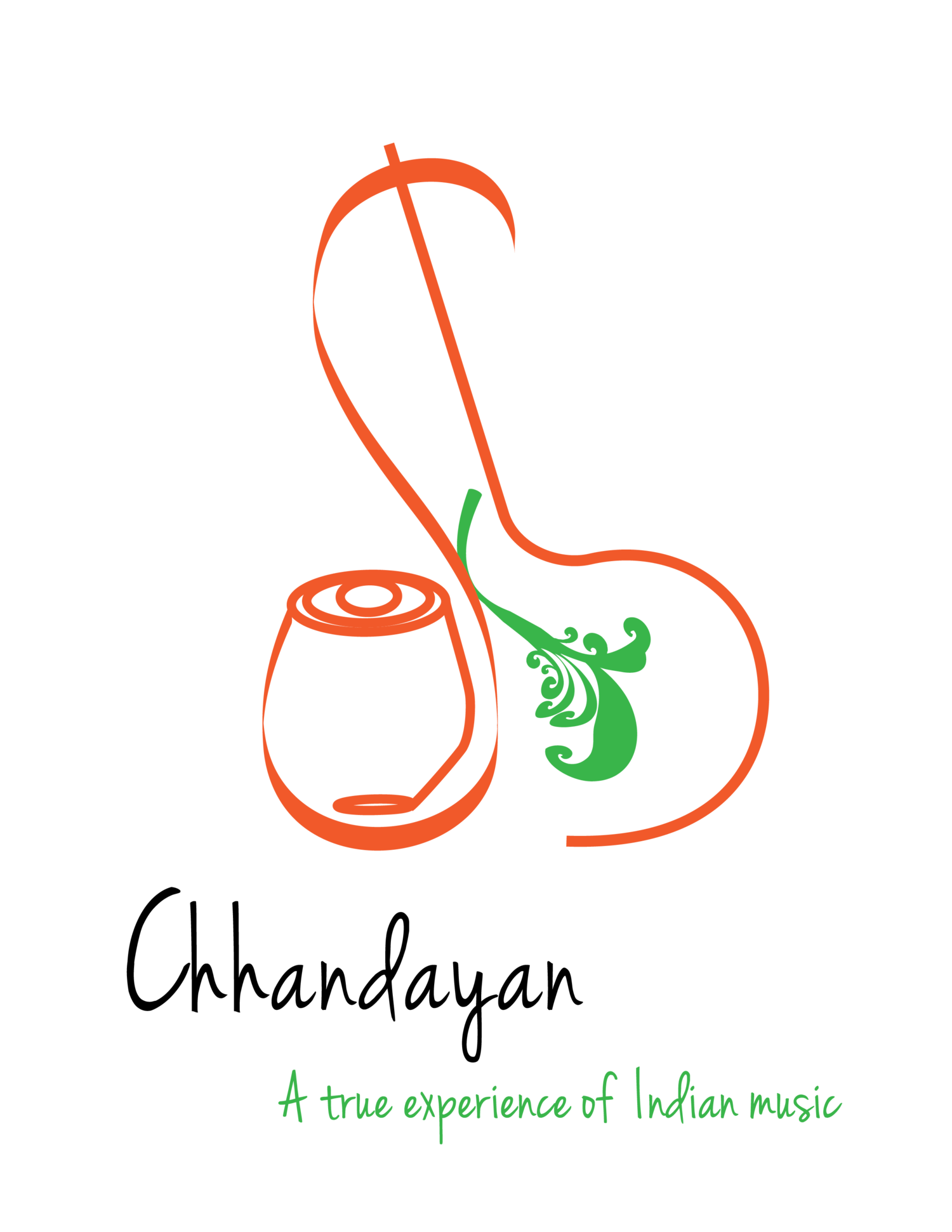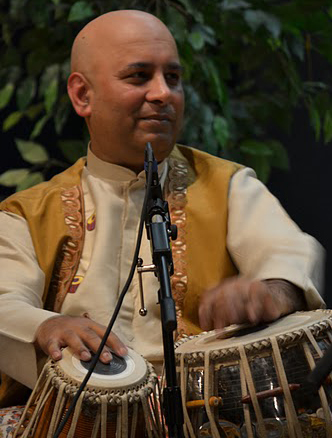This Masterclass will be focused on the common aspects of rhythm applied in music and dance. It will be conducted by Samir Chatterjee, President and Head of Percussion Faculty of Chhandayan. He is also currently on the faculty at the University of Pittsburgh, New School for Jazz and Contemporary Music and Manhattan School of Music and has taught at several reputed institutions worldwide for over four decades. In his illustrious career as a performer, teacher and scholar he has gained invaluable insight into the practical, philosophical and spiritual possibilities embedded in music.
Online participants may please send us your question/s or comments to 646 281 4062 / classes@tabla.org
Samir Chatterjee
Samir Chatterjee is a virtuoso Tabla player from India. He travels widely across the world throughout the year performing in numerous festivals as a soloist or with other outstanding musicians from both Indian and non-Indian musical traditions. Samir performed at the Nobel Peace Prize ceremony in Oslo, Norway in 2007. He also performed a few times at the United Nations General Assembly. His compositions are widely acclaimed as well as his writings. Samir is a firm believer in the transforming effect of music on the society and all aspects of his work reflects this conviction.
Chatterjee began his studies early with Pandit Bankim Ghosh, Pt. Balaram Mukherjee, Pt. Rathin Dhar and Mohammad Salim. His later formation as a musician occurred under the guidance of Pt. Amalesh Chatterjee (since 1966) and Pt. Shyamal Bose (since 1984). All of Samir's teachers have been from the Farrukhabad Gharana (school) of Tabla-playing, which he now represents.
Samir is rated ‘A’ as an artiste of Indian national radio and television. He can be heard on numerous recordings featuring as soloist, accompanying many of India's greatest musicians and in collaboration with western musicians of outstanding caliber. In concert Samir has accompanied many of India's greatest musicians including Pt. Ravi Shankar, Ud. Vilayat Khan, Pt. Bhimsen Joshi, Pt. Jasraj, Pt. Nikhil Banerjee, Pt. V.G. Jog, Pt. Shivkumar Sharma, Pt. Hariprasad Chaurasia, M. S. Gopalakrishnan, Ud. Amjad Ali Khan, Ud. Salamat Ali Khan, Smt. Lakshmi Shankar, Pt. Manilal Nag, Ud. Ali Ahmed Hussain, Ud. Aashis Khan, Dr. L. Subramanium, U Srinivas, Ud. Naseeruddin Sami, Smt. Veena Sahashrabuddhe, Ud. Shujat Khan, Ud. Saheed Parvez, Pt. Ajoy Chakraborty, Ud. Nishat Khan, Ud. Rashid Khan, Pt. Tejendra N. Mazumdar, Pt. Debashish Bhattacharya, Smt. Arti Anklekar, Smt. Kaushiki Chakraborty, to name only a few.
Samir Chatterjee lives in the New York-New Jersey area, and has been a catalyst in the fusion of Indian and Non-Indian music, in his own creations and others as well. He performs with Pauline Oliveros, William Parker, Branford Marsalis, Ravi Coltrane, Joshua Bell, Yoko Ono Lenon, David Liebman, Oliver Lake, Dave Douglas, Ned Rothenberg, Mark Dresser, Mark Feldman, Jerome Harris, Eric Friedlander, Steve Gorn, Glen Velez, Boby Sanabria, Jin Hi Kim, Min Xiao-Fen, Dance Theater of Harlem, Boston Philharmonic, Minnesota Orchestra, Ethos Percussion group, Da Capo Chamber Orchestra, Boston Musica Viva and other jazz, classical and avant guard musicians and ensembles. He also collaborates with Sufi-Rock singer Salman Ahmad of Junoon from Pakistan. He is the composer and director of Indo-Flame – a blend of Indian and Flamenco dance and music, Chhand-Anand - a world percussion ensemble, RabiThakur – a ballet on the life of Tagore, Meghadootam – a feature program of music and dance on an ancient Indian poem, and Dawn to Dusk and Beyond – on the effect of music on humans and nature. He performs with Sanjay Mishra on his CD "Blue Incantation" featuring Jerry Garcia as guest artist.
Samir Chatterjee has been teaching for the last 35 years and many of his students are established performers. He is the Founder-Director of CHHANDAYAN, an organization dedicated to promoting and preserving Indian music and culture. He has authored a comprehensive 654-page book entitled A Study of Tabla, a guide book to Indian music titled Music of India and Those Forty Days, a journal of an austere practice regimen. He is on the faculty at Manhattan School of Music, University of Pittsburgh and New School for Jazz and Contemporary Music. He also taught at the Yale University, Columbia University, New York University and Princeton University, among many other major institutions in the USA, Europe and India. He also contributes to several newspapers and periodicals. He won gold medal for his proficiency in a musical examination and has two Master degrees, in English and History.
Since June 2008 Samir started working relentlessly towards the musical revival of Afghanistan. He made several trips to the country working with different levels of the society and administration and within a very short period of time was able to make a remarkable difference in the cultural life of the country. He is the recipient of several awards such as the Sunshine Award, Jadu Bhatta Award and Acharya Varistha Award.
Reviews
This was almost painfully reflective music, ending, finally, in an exuberant improvisatory interchange with Samir Chatterjee, whose Tabla playing also seemed less percussive than vocal. – The New York Times, 11/10/94.
The superb tabla player Samir Chatterjee joined the conversation in the second movement, pulsing tribute to the legendary Indian violinist L. Subramanium, and the music kicked into high gear, Kurkowicz’s scurrying violin riding Chatterjee’s intricate drumming over Technicolor splashes from the orchestra. Chatterjee’s solo legerdemain foreshadowed a violin cadenza, improvised by Kurkowicz in a slightly disparate Romantic style; an extended give-and-take between the two enthused soloists anchored the finale, framed by a torrential, exuberant tune up by the entire band, propelled by Chatterjee’s rhythmic authority and Kurkowicz’s energy. – Boston Globe (Matthew Guerrieri), October 22nd, 2007 about Swara Yantra of Shirish Korde performed with Boston Philharmonic
Tabla player Pandit Samir Chatterjee is a walking history book when it comes to Indian music. – WNYC (NPR)
This (‘Phoolan Devi Songs’ with Da Capo Chamber Orchestra at Markin Concert Hall) is a colorful, attractive piece, set on a lush, gaudy bed of amplification, aiming at an entertaining stylistic fusion; ….The highlight was the tabla playing of Samir Chatterjee in the final scene, which stood out from the other instruments with the kind of vivid, exciting performance that draws Western composers to a non-western music in the first place. - Anne Midgette, The New York Times, June 8th, 2006
The remarkable tabla virtuoso Chatterjee's playing is rather unique among tabla artists as his impeccable mastery of rhythm is expressed with a rather vocal-like quality. His tabla speaks the patterns, adding a commentary to the rhythm and interplay with the sitar. A fine collaboration. - Allan Evans, Rhythm September 1996
Chatterjee is a good foil for the sarangi virtuoso, as his drumming works in the service of the raga and of Mishra. There is none of the flashy "bird-in-a-bottle" showboating, which has infected much of contemporary tabla drumming. Mr. Chatterjee's solid support and sense of restraint are to be commended. - Richard Henderson, The Beat
Chatterjee, who can sing and then play back the most complex patterns in the manner of great masters, also senses how to highlight more compact, swing-oriented parts through shifts in accents and dynamics. – The Boston Globe, October 16, 1998
Samir Chatterjee gave detailed and forceful Tabla Lahara (solo) in ‘Jahamptal’. The crispness and clarity of his ‘bol’s and balanced synchronization of ‘Tabla’ (the right- hand drum) and ‘Bayan’ (the left-hand drum) made his recital quite enjoyable. – The Statesman, Calcutta, 08/29/87.
Tabaliya Samir Chatterjee made audibly visible those divisional breaths-in-rhythm that is as much music as music itself. His intimate and broadened stretch of motif accentuation, his extemporizations, richly surrounded the dance figures wrought by Jonathan Hollander. Samir’s rhythmic play acted as a continuous narrative, capable of solemn declamation as well as celebration of the human form and of the life-giving elements of nature. – Sruti, March, 1996.
Displaying consummate control and perfection, the artiste (Samir Chatterjee) enthralled the listeners with a very traditional and systematic exposition of ‘Jhamptaal’. Some of the ‘Quidas’ and ‘Tukre’ (types of compositions) were delectable for their intricacy and close finishing. –The Telegraph, Calcutta, September, 1987.
The concert became more enjoyable due to the high quality of accompaniment of Samir Chatterjee on the tabla. The distinct and defined tone of his bols filled the atmosphere with melody. – Anandabazar Patrika, Calcutta, 03/09/90.
The movement inventions were equally unpredictable. Neil Applebaum traded increasingly complex and spontaneous rhythmic patterns with Samir Chatterjee in “Tabla Tap Talk”. – The Washington Post, 8/17/96.
On Blue Incantation, guitarist Sanjoy Mishra’s compositions reveal an intriguing and ingratiating raga influence, underscored by Samir Chatterjee’s tablas throughout most of the album. Their combined sound during “Bach in Time” (based on J.S. Bach’s gavotte and Rondeau from Lute Suite No.3) is fascinating and quite enchanting. – AUDIO, U.S.A., 1996.
Chatterjee uses the Tabla to add an extra melodic touch, rather than remaining limited to a percussive role. – InPittsburg, 09.09.98
SYNC’s first album 'PORT OF ENTRY' does not at all sound effortfully avantgardistic or experimental - as one might have expected of a musician with Ned Rothenberg's background. Rather than that, the eight tracks come across in an explicitly harmonic and relaxed manner; a merit, which we attribute mainly to Samir Chatterjee, whose Tablas provide a percussive basis of an airy, light-footed quality. Rec'order pages - 22.02.99
“Unusual techniques require unusual technicians”. In SYNC’s PORT OF ENTRY Samir Chatterjee weaves his discreet drumming. It is especially the warm-sounding and intimate Tabla-accompaniment by Chatterjee, which fuses differing concepts of Jazz into one term: openness. From the Northern Indian regions Chatterjee brought along that sound which appeals so religiously, but nevertheless - or maybe just because of that feature - adds remarkable accents to the western-urban-oriented music. Jazzthetik Nr. - 01.02.99
And not enough praise can be given to Samir Chatterjee's tabla playing, which supported almost all of the musical material (many sequences, both musical and choreographic, were dubblings of the tabla). - Theodore Bole, bay Windows 05/04/00
‘Seductive drumming of Samir’. – The Morning Call, Allentown, PA, 05/17/95.
Both the artists were accompanied on the Tabla by Samir Chatterjee, who added color to the entire performance. – Daily Bhaskar, Bhopal, 03/18/81.
The glory of the program's first half was Samir Chatterjee's "Rite Rhythm," composed last year for Ethos and Eric Phinney, who is currently studying with the distinguished Indian Tabla player. The work features percussion from all over the world, including Africa, Asia, the Middle East, and America. ... The work had all four players participate in a complex rhythmic dialogue that remained miraculously comprehensive.

